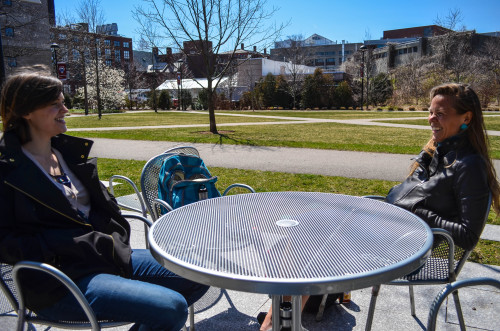
Ashley Clements, HDS MDiv Alum, Class of 2016
“In the way that the cells of the liver comprise the liver, and the liver is one of many organs that comprise the human body, in an expanded metaphor, we humans are also one organ, a collective species. We’re of the same matter. So we need to treat each other as such. Of course, there are different pathways to engaging the divine, but we have to remember that we’re all here working together. We’re all one heart.”
Ashley graduated with a Master of Divinity degree in May 2016. She will begin a Hospital Chaplain Residency at Brigham and Women’s Hospital this fall and is pursuing ordination as an interfaith chaplain.
Before HDS
I was working at Life Alive restaurant with a band of sisters. I’d been doing hospice for a bit because I was in a phase of discernment about whether working with end of life care and in a chaplaincy role was a right vocational path to follow. Also, as I lived here in Boston, I was on HDS campus all the time to really suss it out. That year was a mix of applying to HDS, settling into the idea of doing chaplaincy, and working a job that I loved with people I loved.
Discerning Chaplaincy
My background is international development work. After graduating from college I was hired to work for the International Rescue Committee in Thailand, but decided that something else was needed at that moment, namely to slow down.
I moved to Boston and here my spiritual life exploded. The death and dying realm was something that was very comfortable to me. In my dreams, even, I helped spirits pass on. So I wondered how to make this a vocation.
It happened literally as an “aha” moment. While riding my bike across the Mass Ave. bridge, a thought just dropped into my consciousness, “Why not be a chaplain?” I could represent a mystical interfaith perspective and work within a lot of institutions.
The Walk-In Moment
After that epiphany, I went to Brigham and Women’s Hospital because I was specifically considering hospital chaplaincy. There was a door that said “Chaplain” so I knocked on it. And this man, Ron Hindelang, chatted with me for an hour–an hour!–about hospital chaplaincy versus hospice and all the steps required to pursue a career.

Hospital Chaplaincy
I am particularly interested in addressing people’s true needs. I love going to the depth, to the sedimentary levels of people’s existences, their souls, their psyches. In the hospital I’ve found that people are in a space where they are not only wanting or willing, but sort of yearning, to address deep things.
As chaplains, we are there to listen, to care and add support. And that’s a very sacred thing.
Theosophy
“Theo” means divine and “sophia” is wisdom, so it’s the study of divine wisdom. It’s not a religion; there isn’t a set creed.
The Theosophists were a cohort of these brilliant mystics, clairvoyants, channels that decided to comb through religious, philosophical, scientific materials as well as literature and try to make a map of reality. They discovered that there were many similarities across disciplines and traditions, across time and space.

The Theosophists were also interested in ethics, and said if you look at Jesus and Buddha and Mohammed and various religious figures, you will find that there is a core of ethics.
They wanted to promulgate these similarities, these ethics. The thought is that we’re siblings. In the way that the cells of the liver comprise the liver, and the liver is one of many organs that comprise the human body, in an expanded metaphor, we humans are also one organ, a collective species. We’re of the same matter. So we need to treat each other as such. Of course, there are different pathways to engaging the divine, but we have to remember that we’re all here working together. We’re all one heart.
